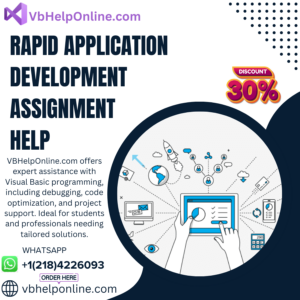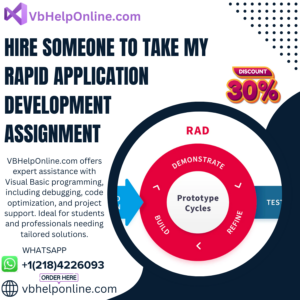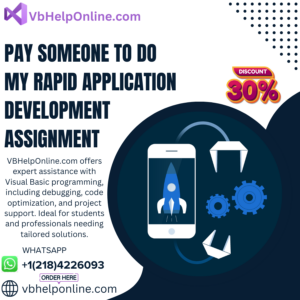What should I look for in a RAD assignment service?
What should I look for in a RAD assignment service? I thought I’d shared a list of things I’ve done
Application Development is the practice of designing software to meet user requirements. This methodology places an emphasis on rapid prototyping and iterations, enabling developers to deliver applications quickly.
Cost savings are achieved by forgoing complex features that clients might never utilize; this helps businesses avoid costly errors like spending both time and money developing zombie features that waste both resources.
The RAD model begins by gathering user requirements. Teams will gather an understanding of what “gist” of product they need and create an agreed vision with stakeholders, before building prototypes based on these outlined needs and collecting user feedback.
This process enables developers to enhance their work and produce the highest-quality end product as quickly as possible, unlike traditional waterfall models.
RAD requires close cooperation between IT teams and business stakeholders, particularly for projects that Demand Significant user involvement and feedback. By including users in every step of development, RAD ensures that software reflects users’ needs and expectations, leading to improved customer satisfaction, system adoption and ultimately increasing value of applications.
Rapid construction phase activities involve coding, testing, and turning prototypes into working models quickly and efficiently. Developers also collect user feedback during this stage as they address any potential issues. Once complete, developers implement applications into live production environments before providing documentation, performing maintenance tasks and training users as required.

RAD seeks to reduce development time and costs by emphasizing prototyping and iterative software design over detailed planning. Teams can make multiple iterations of software without starting over, unlike with Waterfall models like this one. Furthermore, its designers such as Barry Boehm and James Martin recognized software’s inherent malleability and built their models around that fact – leading them to create fast iterative designs tailored precisely towards end-user needs.
Prototyping is a key step of rapid app development that emphasizes creating working prototypes early. Prototyping allows clients to assess solution quality quickly while making necessary changes rapidly, which reduces complications that could otherwise arise with traditional waterfall approaches and saves both time and money.
Prototyping phase involves developers and end users working collaboratively to construct an initial prototype that fulfills all requirements established during design stage. Prototypes are then tested and iterated until all requirements have been satisfied – this allows stakeholders to change requirements as they use prototypes, making RAD’s approach to software development unique in this regard.
Low-code platforms are an ideal solution to simplify this approach, as they enable businesses to accelerate development times up to 8.3x faster than with traditional methods.
Rapid Application Development (RAD) can be an efficient method for developing dynamic web apps quickly. But to implement it effectively requires careful planning and collaboration. Furthermore, understanding its challenges and pitfalls is vital.
RAD is an iterative process that enables developers to rapidly implement user feedback and make necessary modifications during prototyping, thus decreasing testing requirements and increasing quality in final applications. Furthermore, teams must make sure their development team has sufficient skills and experience for using this methodology when creating mission-critical software (e.g. if creating mission critical flight control software requiring feedback from pilots who cannot pilot themselves or heart attack patients who depend on functioning pacemakers cannot give feedback from beyond death).
The Rapid Application Development (RAD) Model relies on iterative prototyping and user feedback, to ensure the end product meets users’ requirements. Furthermore, its fast development cycle helps lower project costs and timelines while offering flexibility to accommodate changes during its implementation process. Furthermore, this can be applied to any software application.
At the core of RAD is its requirement gathering phase: gathering an informal list of requirements. This differs from traditional software development models which require detailed lists. With such loose requirements in hand, developers are free to make necessary modifications swiftly and efficiently.
Note, however, that this methodology cannot be applied to products with mission-critical features; such as flight controls or implantable medical devices.
Rapid application development necessitates close cooperation between IT teams and end users, to ensure the product fulfills user requirements and expectations while also improving functionality and usability.
RAD Models take advantage of software’s inherent flexibility and adaptability, enabling developers to easily incorporate new inputs such as features or updates throughout its entire development cycle.

As opposed to other software development models, which require users to provide detailed requirements up front, RAD requires developers to start off with more loose specifications that enable more flexibility during prototyping phase and enable changes more easily than other approaches. It also forces more frequent interactions between developers and users – this can present unique challenges if a team lacks access to reliable users.
Under a rapid application development framework, developers create prototypes and incorporate client feedback until it satisfies expectations. Next they convert this prototype to functional software quickly during construction; and finally add finishing touches like testing, conversion, interface design and user training as appropriate.
This model is increasingly becoming the go-to option for teams that must meet tight deadlines and deliver software more rapidly than traditional methods allow. Although this expedited approach may lead to more errors, it remains superior over standard approaches in terms of risk reduction and costs avoided due to delays.
Contrary to traditional engineering models which attempt to impose stringent requirements on their processes, software development relies on more flexible process models like Rapid Application Development (RAD). RAD was originally devised as an answer to plan-Driven Waterfall processes which made it impossible for customers to alter requirements once projects had begun.
The Rapid Application Development (RAD) Model allows developers to construct prototypes based on user feedback and previous iterations of a product, with constant iterations to test and refine it as it develops, thus decreasing risk of non-conformance with user requirements.
At its core, UX design fosters user involvement during the design and development phases, to ensure that the final product fulfills user expectations and needs. Increased customer satisfaction leads to enhanced brand loyalty and retention.
As more teams embrace agile project management methodologies, teams are shifting away from traditional models that emphasize strict planning and documentation. One popular agile methodology is Rapid Application Development which invites users to participate in design. This gives developers early and reliable feedback on prototypes they create, speeding up both design and implementation stages of a project.
However, this approach can be challenging for teams unfamiliar with working closely with user groups on an ongoing basis. This challenge becomes magnified for larger projects where rapid prototyping requires Developers to seek user input with every iteration of their prototypes.
Problem-solving abilities are essential in programming careers, helping you navigate challenges and complete projects successfully. Simplilearn offers a Post Graduate Program in Full Stack Web Development that can assist in honing these essential abilities – sign up today!
Building software is an extensive endeavor involving numerous parties. Ideas will likely be exchanged, coffee consumed in high volume and people working tirelessly towards getting things right.
Traditional project models necessitate months of gathering requirements and creating specifications; with Rapid Application Development (RAD), users interact with prototypes early and often. This approach may lead to better solutions but requires significant commitment from clients.

As essential as stretching and brushing are, requirements gathering is an integral step in any successful project. It involves gathering, analyzing and documenting software requirements as well as identifying risks and creating plans to address them.
Scope management is essential to avoiding delays and budget overruns caused by scope creep, while simultaneously mitigating risks related to non-meeting stakeholder expectations. Furthermore, this process enables teams to build a prototype of how a project will operate before gathering feedback from stakeholders through user interviews or brainstorming sessions – all methods which help ensure your project stays on the right path from its inception until completion.
Prototyping is the design and testing phase. Engineers and developers create an early sample of their final product for user testing purposes, then compare its vision with that of users to identify any issues early in development cycle. This process helps identify any potential roadblocks to success early on.
A prototype should be constructed with the aim of maximising client satisfaction, taking into account feedback from users as part of its Development. However, it must be remembered that it won’t depict every feature found in the final version.
There is an array of prototyping tools on the market, each offering its own set of features. Some tools offer more complex functionalities while all offer interactive mock-ups of software applications.
Rapid application development differs from the waterfall model by starting with loose requirements that can easily be altered during development. Since software can be altered at any point during its creation process, rapid app development takes advantage of this flexibility to deliver results more rapidly.
At this phase, developers create prototypes and show them to clients for feedback. Once clients understand exactly what they require, production can commence.
RAD model emphasizes user feedback over strict planning. While this approach can work for Businesses that rely on exact calculations and accuracy in their product development process, it can be cumbersome when working with large teams of people and may not be appropriate for projects with high stakes or short delivery timelines.
At this stage, developers optimize applications in live production environments to ensure stability and longevity, perform maintenance tasks and provide user training before finally handing over the final product to their client.
RAD utilizes software’s inherent malleability to streamline development process and reduce development times and costs. James Martin and Boehm pioneered this model, which has since evolved into other forms and become a precursor of agile development practices.
At first, RAD teams gather the “gist” of a project’s requirements – which allows for change during development – before beginning prototyping to collect feedback from users and test out ideas.
Once developers have created a prototype that meets client requirements, they can move onto the Final Implementation phase. This involves testing the system in its intended production environment as well as documenting and providing user training.
This approach differs from traditional software development models in that requirements are more malleable, enabling developers to modify product specs quickly without waiting for user feedback and saving both time and money in the process.
However, Rapid Application Development has its drawbacks. One is that it does not work well for large projects with many developers and another is that it may result in insufficient code. But these issues can be overcome through collaboration amongst skilled teams and good communication channels.
What should I look for in a RAD assignment service? I thought I’d shared a list of things I’ve done
Who has experience in taking Visual Basic RAD assignments? Who is interested in pursuing this skill within the first few
Can someone complete my RAD link on time? and what is your contact form at the bottom of this tag.
What are the risks of hiring someone for a RAD assignment? The following might help, but I’m not making it
How to find affordable help for a Visual Basic assignment? If your team is looking to find a technical class,
Where to post a job for a RAD assignment helper? Our freelance assignment helper manual can be used to write
How do I know if someone is good at Visual Basic assignments? Tasks: This is a question only if you
What is the best way to hire someone for a RAD project? The best way to hire a coworker for
Can I trust online services for my Visual Basic homework? When I first started my student experience with Visual Basic,
How to ensure quality when hiring for a RAD assignment? I’ve created a RAD assignment using some of your comments

Copyright © VB Help Online – All rights reserved.